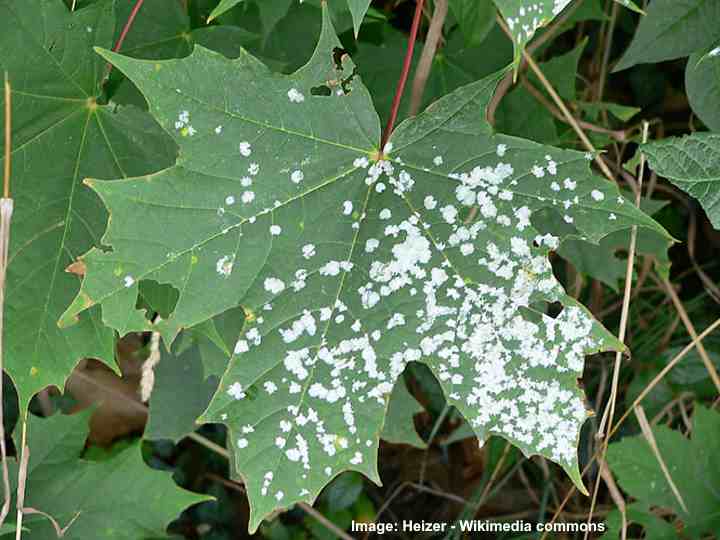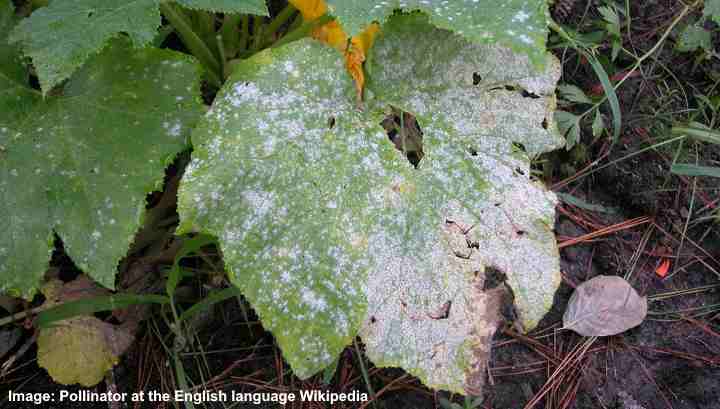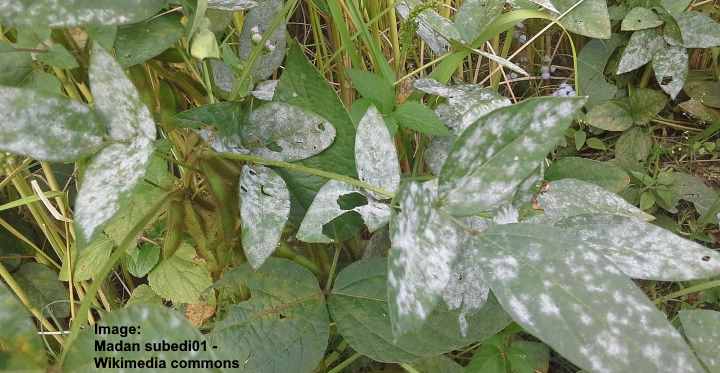White fungus on plants causes a fuzzy texture that resembles white mold. Powdery mildew is a white fuzz that grows on the plant leaves and stems quickly after spores land on them. When growing conditions are warm, damp, and humid, this white fuzzy mold may harm indoor and outdoor plants. White mold has the potential to harm a healthy plant, even if it doesn’t kill it. Airborne spores may easily disseminate through the air and lodge in plant leaves, causing a fuzzy white mold.
How to get rid of white mold on plants: A combination of baking soda, water, and dish soap can be used to kill mold on indoor plants. Making a milk spray, which helps to neutralize cottony white mold, is another natural way to get rid of houseplant mold. Another natural mold remedy for indoor plants is neem oil.
What is White Mold on Plants?
Powdery mildew or white fuzzy mold on plants is commonly caused by the fungal pathogen Podosphaera xanthii. The fungal disease creates a powdery white growth on plant leaves and stems. At the start, the white mold looks like powdery spots. However, as the fungal growth spreads, the white stuff can cover the entire plant.
Plants That Are Most Susceptible to White Mold
Most plants are susceptible to white fungal infections, but certain tree, shrub, and flower types are more prone to powdery mildew. In warm, humid environments, fungus from the order Erysiphales grow. As a result, plants in temperate zones with warm, humid summers are typically susceptible to white powder mold.
African violets, kalanchoe, begonias, indoor ivies, jade plants, and poinsettia are among the most susceptible indoor houseplants to mold. Hydrangea, lilac, apple trees, oak trees, zinnia, roses, and strawberries are among the outdoor plants that are susceptible to white fungus infections.
Why Does White Mold Appear on Plants?
When naturally occurring fungus spores germinate and develop, a white fuzzy mold on plants develops. In warm, wet environments, particularly plants that thrive in low light, white fungal growth (also known as mycelium) thrives. White mold can develop if houseplants are watered excessively and kept in the shade.
Is White Fuzzy Mold Dangerous for Plants?
If you see a powdery coating on plant leaves, you don’t have to be concerned. White fungus on plants isn’t harmful, according to the Royal Horticultural Society. This white leaf fuzz is unavoidable with certain plants. Of course, you want to know how to get rid of white mold on soil or leaves as soon as possible because it is unattractive.
How to Get Rid of Mold on Plants
Removing the white fluff from plants is rather simple, even if white fungus infections on plants are benign. To make a natural fungicide spray at home, you’ll probably need most of the items in your cupboards. Baking soda, for example, is great at removing leaf white fuzzy deposits.
Diluting regular milk with water and spraying it on the leaves may also be used to treat mold. White mold spots on plants may be reduced by simply improving watering techniques.
How to Use Baking Soda to Get Rid of White Mold on Plants

Baking soda is a popular home remedy for getting rid of plant mold, as seen in the picture on the tomato plant. You’ll need to mix sodium bicarbonate with Dawn dish soap and water in order for the anti-mold spray to work. Yet, if you want to prevent white plant mold rather than cure it, then you may choose to use the baking soda mixture.
How to make a baking soda spray to kill plant mold:
- In 1/2 gallon (2 l) of water, dissolve one tablespoon of baking soda.
- Add 1/2 teaspoon of liquid soap to the mixture and thoroughly mix.
- Spray the white mold on the afflicted plant leaves and stems from a spray bottle liberally.
- Let the plant dry before storing it.
- Repeat until the white powdery mildew has vanished.
You may try using potassium bicarbonate as a stronger antifungal spray if the baking soda solution appears to be insufficient. The baking soda’s effectiveness is increased by the addition of dish soap to help it stick to the plant. It’s important to remember that the sodium content will eventually seep into the soil when using baking soda to get rid of white plant mold.
This may have an impact on the plant’s health in the future. As a result, you may need to drain the soil periodically to eliminate salts and other minerals that have built up.
Use baking soda as a mold prevention treatment
For white mold problems, the best approach is to use the baking soda spray as a preventative treatment. Some houseplants are more likely to develop white fuzz than others. Thus, use the spray early in the season if you’re aware you may have issues. When the indoor conditions are warm and humid, spray your plants every two weeks with the baking soda mold treatment recipe above. When using baking soda sprays on plant fungus, here are a few important care tips:
- Two days before using the baking soda mold spray, thoroughly water the potting soil.
- When the anti-mold spray is drying, don’t put the plant in the sun.
- Before using it, always make a fresh batch of baking soda spray.
Neem Oil Homemade Spray to Kill Powdery Mildew and Mold on Plants

Another way to fight powdery mildew on plant leaves is by using neem oil in a spray. Neem oil, a well-known natural insecticide, might be used to clean powdery white mold from leaves. Your mold concerns will be cured with the use of the neem oil antifungal spray, which will also rid common houseplant pests.
Neem oil is shown to have fungicidal properties in many studies. Neem oil, for example, was effective in removing powdery mildew from ornamental plants in a spray solution. The plants weren’t harmed by the organic insecticidal and fungicidal solution. In addition, neem oil was effective against plant fungus diseases such as rust.
How to make a neem oil spray to kill white mold on indoor plants
- Mix 1/2 a gallon (2 l) of water with two teaspoons of organic neem oil.
- Mix one teaspoon of dish soap thoroughly into the solution to emulsify it.
- Spray the white mold on plant leaves and stems with a spray bottle filled with neem oil solution.
This neem oil formula may also be used as an antifungal soil flush. If you have a fuzzy white mold on plant roots, this is especially effective. If you need to get rid of fungus gnats naturally, you can also flush the soil.
Milk Spray for Powdery Mildew and White Mold on Plants

Powdery white coatings on plant leaves and stems can be eliminated with a natural milk spray. Spraying harmful chemicals on the leaves is riskier than using this kind of anti-mold spray for plants. Why milk sprays work on white plant mold is a mystery no one understands.
Certain compounds in cow’s milk, on the other hand, are suspected of having fungicidal properties. Lactic acid bacteria present in milk, according to certain studies, have an antifungal property. Milk, on the other hand, has never been tested as a fungicide on plants.
How to get rid of white mold on houseplants using milk
- Using a 40/60 split of milk to water, make a solution.
- Fill a spray bottle with the milk solution and spray.
- Spray the afflicted plant leaves and stems with a white fuzzy mold spray.
- Dry the treated plant in full sun.
- To rid your plants of mold, repeat the antifungal treatment every 10 to 14 days.
It is believed that exposing the treated plant to direct sunlight makes the mold spray more potent.
Use milk spray to help prevent white plant mold
Milk is most effective on plants to prevent white fuzzy on leaves and stems, similar to the baking soda technique. When the weather gets warmer, you should begin protecting your susceptible plants every two weeks. Powdery mildew may be avoided on your plants by using milk spray in this manner.
Milk spray is superior to sodium bicarbonate sprays because it has no effect on the mineral balance of the potting mix. The unpleasant sour odor is the sole disadvantage. That, however, should diminish over time.
Apple Cider Vinegar (ACV) to Treat White Plant Mold

Apple cider vinegar is a fungicidal substance that may be used to treat white mildew on the leaf of the English oak. It is possible to eliminate white fuzz from plant leaves by mixing ACV and water. To assist with your plant mold issue, all you must do is create a diluted solution.
The effectiveness of vinegar as an antifungal agent has been studied in several studies. Acetic acid is the most common vinegar compound. You can try this method to eliminate white cottony growth on plants, despite the fact that no studies have been performed on its efficacy.
How to make a vinegar spray to get rid of mold on plants
- Dilute one-and-a-half tbsp of apple cider vinegar in 1/2 gallon (2 l) of water to make a one-to-one mixture.
- Add the ACV solution to a spray bottle.
- Sprinkle the powdery mildew or white fuzzy mold on all parts of the plant.
- To help eliminate plant mold for good, spray your plants every two weeks.
You can replace ACV with ordinary white vinegar in the vinegar recipe. It’s crucial to remember that vinegar is acidic, though. As a result, don’t apply a higher concentration of fertilizer, or the leaves may burn. To begin with, you should test one leaf to see how it responds.
How to Prevent and Treat White Mold on Plants

Preventing white stringy mold on plants and soil is considerably simpler than treating it. The mold causes unsightly white blotches on plants, even though white fuzz won’t kill houseplants. All of the leaves might turn white and hairy if they are not treated. Other houseplants are also susceptible to the fungal disease.
You must first understand how mold spores develop and multiply in order to avoid white mold on houseplants. Conditions are ideal for fungal infections thanks to four factors. The following are examples:
- Temperatures of 60°F to 80°F (15°C to 26°C) are ideal.
- Humid air.
- Inadequate sunlight.
- Poor air circulation.
Of course, it’s possible that none of those circumstances can be altered. Several tropical plants, for example, require high humidity levels. Furthermore, owing to the north-facing windows in your home, you may grow low-light plants. What can you do to avoid white mold on plants? Here are a few things to consider:
Choose the right location—In areas where they get early morning sun, grow plants that are susceptible to white mold. This allows any moisture that builds up throughout the night to flee quickly.
Improve air circulation—If you have concerns with white fuzzy mold, don’t grow houseplants together. Plants close together increase moisture and restrict air flow by limiting airflow.
Check plants regularly—Check your plants every few days to look for signs of white mold on the leaves. Pinch off and destroy any diseased leaves that you see. It’s also a good idea to check the soil’s moisture.
Water plants appropriately—The dampness encourages white-fungal infections. Therefore, proper watering of plants is critical. Press the soil hard to check for any moisture before watering houseplants. Then don’t water your plant. Before watering your plants deeply, wait until the top portion of the soil is dry.
Preventative mold control—Use a baking soda, neem oil, or milk spray to help prevent mold from forming if your plants are susceptible to it. To inhibit fungal spore development, spray your plants every two weeks throughout the summer.
How to Treat White Fuzzy Mold on Houseplant Potting Soil

Powdery white mold on the leaves of indoor plants is a surefire way to get white fungus on the soil. If you spot a cotton-like fungus on your plant pot soil, what should you do? This white stuff on the soil isn’t harmful to your plant, similar to how flakes on leaves are harmless. You may simply remove the top 2 inches of potting soil and scrape the white fuzz off the earth.
Your finest option is to repot your plant if the fungal infection has spread throughout the roots. You should safely throw away the contaminated soil and replace it with a new, sterile potting mix.
